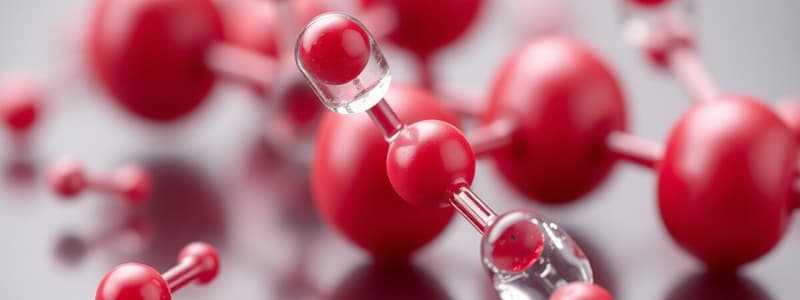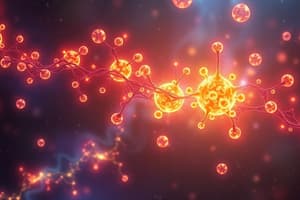Podcast
Questions and Answers
Why is bethanechol, rather than carbachol, typically preferred for stimulating the GI and urinary tracts?
Why is bethanechol, rather than carbachol, typically preferred for stimulating the GI and urinary tracts?
- Carbachol is more susceptible to acetylcholinesterase, resulting in a shorter half-life and reduced efficacy.
- Carbachol is less potent at muscarinic receptors compared to bethanechol, requiring higher doses for similar effects.
- Carbachol has significant nicotinic effects, leading to a higher incidence of unwanted side effects that are not typically seen with bethanechol. (correct)
- Carbachol is more readily antagonized by atropine, making it less reliable for therapeutic use in stimulating smooth muscle contraction.
A patient with a history of asthma is undergoing a methacholine challenge test. After administration of methacholine, the patient experiences severe bronchoconstriction. Which of the following best explains this exaggerated response?
A patient with a history of asthma is undergoing a methacholine challenge test. After administration of methacholine, the patient experiences severe bronchoconstriction. Which of the following best explains this exaggerated response?
- Patients with asthma have decreased sensitivity to muscarinic receptor stimulation, requiring higher doses of methacholine to elicit a response.
- Methacholine indirectly inhibits the release of nitric oxide in the lungs, resulting in unopposed bronchoconstriction.
- Asthmatic airways exhibit heightened sensitivity to methacholine-induced bronchoconstriction due to bronchial hyperreactivity. (correct)
- Methacholine directly stimulates beta-2 adrenergic receptors in the bronchial smooth muscle, causing constriction.
A patient undergoing treatment for glaucoma is prescribed pilocarpine eye drops. What is the primary mechanism by which pilocarpine reduces intraocular pressure?
A patient undergoing treatment for glaucoma is prescribed pilocarpine eye drops. What is the primary mechanism by which pilocarpine reduces intraocular pressure?
- Pilocarpine directly blocks beta-adrenergic receptors in the iris, leading to vasoconstriction and reduced fluid inflow.
- Pilocarpine reduces inflammation in the anterior chamber of the eye, thereby improving fluid outflow.
- Pilocarpine increases the drainage of aqueous humor through contraction of the ciliary muscle and opening of the trabecular meshwork. (correct)
- Pilocarpine decreases the production of aqueous humor by inhibiting carbonic anhydrase in the ciliary body.
Why might a muscarinic agonist be contraindicated for a patient with a pre-existing risk of peptic ulcers?
Why might a muscarinic agonist be contraindicated for a patient with a pre-existing risk of peptic ulcers?
Why does the topical administration of pilocarpine eye drops for glaucoma result in fewer systemic side effects compared to oral administration of a muscarinic agonist?
Why does the topical administration of pilocarpine eye drops for glaucoma result in fewer systemic side effects compared to oral administration of a muscarinic agonist?
What is the rationale for using epinephrine as an alternative treatment for muscarinic agonist overdose, and what type of antagonism does it exemplify?
What is the rationale for using epinephrine as an alternative treatment for muscarinic agonist overdose, and what type of antagonism does it exemplify?
Acetylcholinesterase inhibitors are described as 'indirect agonists' at cholinergic receptors. Why is this the case?
Acetylcholinesterase inhibitors are described as 'indirect agonists' at cholinergic receptors. Why is this the case?
What is the significance of designating parathion and malathion as prodrugs in discussions of organophosphate poisoning?
What is the significance of designating parathion and malathion as prodrugs in discussions of organophosphate poisoning?
How does the nature of binding (reversible vs. irreversible) of acetylcholinesterase inhibitors influence their therapeutic use and potential toxicity?
How does the nature of binding (reversible vs. irreversible) of acetylcholinesterase inhibitors influence their therapeutic use and potential toxicity?
Compared to acetylcholine, why are synthetic muscarinic agonists like bethanechol less susceptible to breakdown by acetylcholinesterase?
Compared to acetylcholine, why are synthetic muscarinic agonists like bethanechol less susceptible to breakdown by acetylcholinesterase?
A patient presents with urinary retention. Bethanechol is considered, but the patient also has a history of well-controlled peptic ulcers. How does the ulcer history influence the decision to use bethanechol?
A patient presents with urinary retention. Bethanechol is considered, but the patient also has a history of well-controlled peptic ulcers. How does the ulcer history influence the decision to use bethanechol?
What distinguishes carbachol from other muscarinic agonists in terms of receptor selectivity, and how does this influence its therapeutic applications?
What distinguishes carbachol from other muscarinic agonists in terms of receptor selectivity, and how does this influence its therapeutic applications?
The organophosphate insecticide malathion is used topically to treat head lice. Explain the mechanism that allows it to be more toxic to insects than to humans.
The organophosphate insecticide malathion is used topically to treat head lice. Explain the mechanism that allows it to be more toxic to insects than to humans.
Predict the effects of rivastigmine on a patient with Alzheimer's disease, considering its primary mechanism of action.
Predict the effects of rivastigmine on a patient with Alzheimer's disease, considering its primary mechanism of action.
A patient with Sjogren's syndrome complains of persistent dry mouth and difficulty swallowing. How do pilocarpine and cevimeline alleviate these symptoms?
A patient with Sjogren's syndrome complains of persistent dry mouth and difficulty swallowing. How do pilocarpine and cevimeline alleviate these symptoms?
Flashcards
Bethanechol Uses
Bethanechol Uses
Stimulates smooth muscle in GI tract and bladder; used for non-obstructive urinary retention and neurogenic atony of bladder.
Methacholine Challenge Test
Methacholine Challenge Test
A diagnostic test for bronchial airway hyperreactivity, especially when asthma is suspected but spirometry is normal.
Pilocarpine Uses
Pilocarpine Uses
Lower priority treatment for glaucoma and treatment for xerostomia (dry mouth), often after radiation or in Sjögren’s syndrome.
Side Effects of Muscarinic Agonists
Side Effects of Muscarinic Agonists
Signup and view all the flashcards
Minimizing Muscarinic Agonist Side Effects
Minimizing Muscarinic Agonist Side Effects
Signup and view all the flashcards
Atropine Sulfate
Atropine Sulfate
Signup and view all the flashcards
Epinephrine as Antidote
Epinephrine as Antidote
Signup and view all the flashcards
Acetylcholinesterase Inhibitors
Acetylcholinesterase Inhibitors
Signup and view all the flashcards
Reversible Acetylcholinesterase Inhibitors
Reversible Acetylcholinesterase Inhibitors
Signup and view all the flashcards
Irreversible Acetylcholinesterase Inhibitors
Irreversible Acetylcholinesterase Inhibitors
Signup and view all the flashcards
Indirect Agonists
Indirect Agonists
Signup and view all the flashcards
Insecticide/Organophosphate Poisoning
Insecticide/Organophosphate Poisoning
Signup and view all the flashcards
Study Notes
Muscarinic Agonists: Matching and Uses
- Specific muscarinic agonists can be matched to particular therapeutic applications
- Drugs like carbachol and methacholine work better in the GI and urinary tracts
- Bethanechol is favored for GI and urinary effects due to carbachol's nicotinic effects
Carbachol Considerations
- Carbachol has substantial nicotinic effects, making it the least selective agent for muscarinic receptors
- The side effects of Carbachol make it generally avoided
- Carbachol is less susceptible to antagonism by atropine because it also acts on nicotinic receptors
Bethanechol: Bowels and Bladder
- Bethanechol stimulates smooth muscle in the GI tract and bladder
- Bethanechol can be administered orally or subcutaneously
- Bethanechol treats non-obstructive urinary retention and neurogenic atony of the bladder
- It increases urinary and GI motility
Carbachol: Backup for Glaucoma
- Carbachol serves as a backup medication for glaucoma
- It lowers intraocular pressure
- Nicotinic effects limit it's use, meaning Carbachol has least clinical relevance
Methacholine: Diagnosing Airway Reactivity
- Methacholine, given via inhaler, induces bronchoconstriction
- Methacholine helps diagnose bronchial airway hyperreactivity in those without clinical asthma
- The methacholine challenge test gives methacholine via inhaler to constrict the lungs
- Asthma patients show a hyperactive bronchoconstriction response in this test, indicating a positive result
Pilocarpine and Cevimeline: Xerostomia Treatment
- Pilocarpine can treat glaucoma by increasing fluid drainage, although it’s not a first-line choice
- Pilocarpine and Cevimeline are useful for treating Xerostomia (dry mouth)
- Xerostomia can result from head and neck radiation or Sjogren’s syndrome
- Both medicines can be taken orally to stimulate saliva production
- Muscarinic agonists in glaucoma are used to increase fluid drainage
Muscarinic Agonists: Side Effects and Management
- Muscarinic agonists can cause side effects by over activating the parasympathetic nervous system
- Sweating, which is a function of the sympathetic system can be triggered
- Side effects can include pupil constriction, reduced heart rate, and bronchoconstriction
- Muscarinic agonists should be avoided for people at risk of peptic ulcers
- They can increase gastric acid production
- Other side effects are diarrhea, increased urination (leading to potential incontinence), flushing, salivation, lacrimation, and sweating
- Flushing can result from vasodilation via M3 receptor stimulation and nitric oxide release in blood vessels
- Localized administration, like eye drops or inhalers, can reduce side effects
- Orally taken Bethanechol is not well absorbed keeping the side effects mostly to the GI tract
Managing Toxicity
- Atropine, a muscarinic antagonist, is the primary antidote for muscarinic agonist overdose
- Atropine blocks all muscarinic receptors (M1-M5)
- Epinephrine can also counter severe cardiovascular or bronchoconstrictor effects
- It is considered a physiologic antagonist since it acts on different receptors (alpha and beta) to produce opposing effects
Acetylcholinesterase Inhibitors: Mechanisms
- Acetylcholinesterase inhibitors block the enzyme acetylcholinesterase
- They can be divided into reversible and irreversible inhibitors
- Reversible inhibitors are competitive antagonists that bind temporarily to acetylcholinesterase, diminishing the enzyme's activity for a short time
- Irreversible inhibitors bind with covalent bonds, and produce long-lasting effects
- These inhibitors are toxic and have the potential to be very dangerous
Reversible Inhibitors
- Reversible inhibitors are more therapeutically useful and allow the actions of acetylcholine to persist
- They are described as indirect agonists because they increase acetylcholine levels, which then affects both nicotinic and muscarinic receptors
- This can lead to various side effects due to the wide range of effects from increased acetylcholine
Irreversible Inhibitors
- Irreversible inhibitors have limited therapeutic applications due to their toxicity
- Many were designed as nerve agents, such as sarin or VX
- Organophosphate insecticides like parathion and malathion also act as irreversible acetylcholinesterase inhibitors
- Insecticide or organophosphate poisoning should lead you to think about irreversible acetylcholinesterase inhibitors
- Parathion and malathion are prodrugs activated by cytochrome P450, and are toxic
- Malathion is available in topical lotion for head lice
Mechanism of Action
- Acetylcholinesterase inhibitors work in the synapse, where they prevent the breakdown of acetylcholine
- This leads to increased levels of acetylcholine
- The acetylcholine then has a postsynaptic effect on nicotinic and muscarinic receptors
Studying That Suits You
Use AI to generate personalized quizzes and flashcards to suit your learning preferences.



